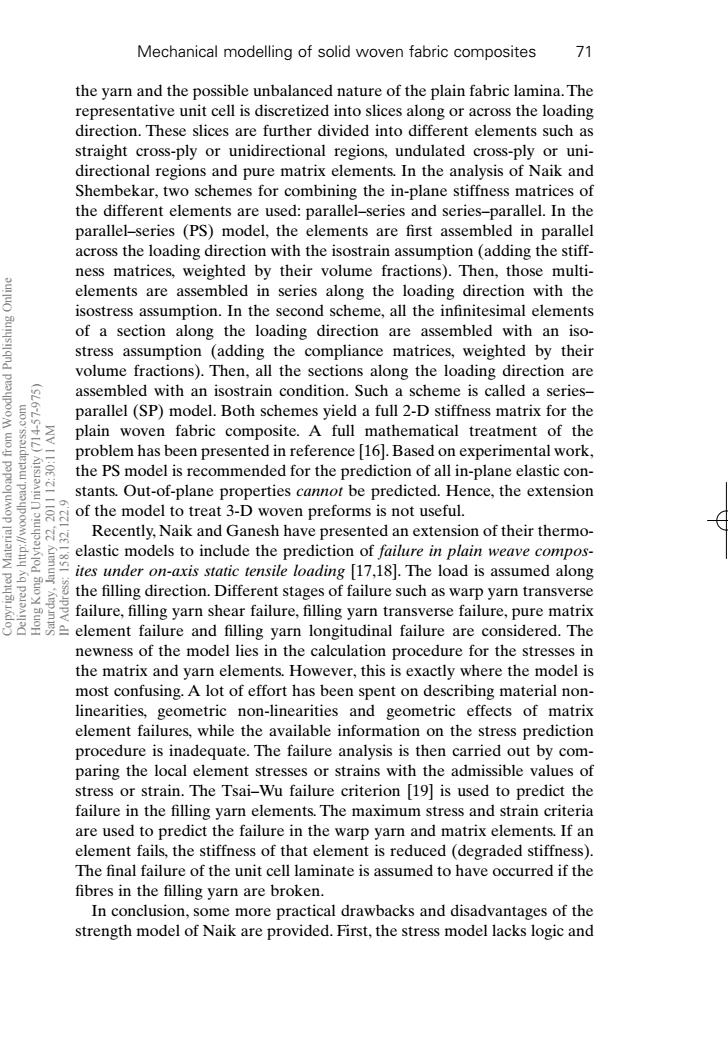正在加载图片...

Mechanical modelling of solid woven fabric composites 71 the yarn and the possible unbalanced nature of the plain fabric lamina.The representative unit cell is discretized into slices along or across the loading direction.These slices are further divided into different elements such as straight cross-ply or unidirectional regions,undulated cross-ply or uni- directional regions and pure matrix elements.In the analysis of Naik and Shembekar,two schemes for combining the in-plane stiffness matrices of the different elements are used:parallel-series and series-parallel.In the parallel-series (PS)model,the elements are first assembled in parallel across the loading direction with the isostrain assumption(adding the stiff- ness matrices,weighted by their volume fractions).Then,those multi- elements are assembled in series along the loading direction with the isostress assumption.In the second scheme,all the infinitesimal elements of a section along the loading direction are assembled with an iso- stress assumption (adding the compliance matrices,weighted by their volume fractions).Then,all the sections along the loading direction are assembled with an isostrain condition.Such a scheme is called a series- parallel(SP)model.Both schemes yield a full 2-D stiffness matrix for the plain woven fabric composite.A full mathematical treatment of the problem has been presented in reference [16].Based on experimental work, the PS model is recommended for the prediction of all in-plane elastic con- stants.Out-of-plane properties cannot be predicted.Hence,the extension of the model Recently,Naik and Ganesh have presented an extension of their thermo- elastic models to include the prediction of failure in plain weave compos- ites under on-axis static tensile loading [17,18.The load is assumed along the filling direction.Different stages of failure such as warp yarn transverse failure,filling yarn shear failure,filling yarn transverse failure,pure matrix 8 element failure and filling yarn longitudinal failure are considered.The newness of the model lies in the calculation procedure for the stresses in the matrix and yarn elements.However,this is exactly where the model is most confusing.A lot of effort has been spent on describing material non- linearities,geometric non-linearities and geometric effects of matrix element failures,while the available information on the stress prediction procedure is inadequate.The failure analysis is then carried out by com- paring the local element stresses or strains with the admissible values of stress or strain.The Tsai-Wu failure criterion [19]is used to predict the failure in the filling yarn elements.The maximum stress and strain criteria are used to predict the failure in the warp yarn and matrix elements.If an element fails,the stiffness of that element is reduced (degraded stiffness). The final failure of the unit cell laminate is assumed to have occurred if the fibres in the filling yarn are broken. In conclusion,some more practical drawbacks and disadvantages of the strength model of Naik are provided.First,the stress model lacks logic andthe yarn and the possible unbalanced nature of the plain fabric lamina. The representative unit cell is discretized into slices along or across the loading direction. These slices are further divided into different elements such as straight cross-ply or unidirectional regions, undulated cross-ply or unidirectional regions and pure matrix elements. In the analysis of Naik and Shembekar, two schemes for combining the in-plane stiffness matrices of the different elements are used: parallel–series and series–parallel. In the parallel–series (PS) model, the elements are first assembled in parallel across the loading direction with the isostrain assumption (adding the stiffness matrices, weighted by their volume fractions). Then, those multielements are assembled in series along the loading direction with the isostress assumption. In the second scheme, all the infinitesimal elements of a section along the loading direction are assembled with an isostress assumption (adding the compliance matrices, weighted by their volume fractions). Then, all the sections along the loading direction are assembled with an isostrain condition. Such a scheme is called a series– parallel (SP) model. Both schemes yield a full 2-D stiffness matrix for the plain woven fabric composite. A full mathematical treatment of the problem has been presented in reference [16]. Based on experimental work, the PS model is recommended for the prediction of all in-plane elastic constants. Out-of-plane properties cannot be predicted. Hence, the extension of the model to treat 3-D woven preforms is not useful. Recently, Naik and Ganesh have presented an extension of their thermoelastic models to include the prediction of failure in plain weave composites under on-axis static tensile loading [17,18]. The load is assumed along the filling direction. Different stages of failure such as warp yarn transverse failure, filling yarn shear failure, filling yarn transverse failure, pure matrix element failure and filling yarn longitudinal failure are considered. The newness of the model lies in the calculation procedure for the stresses in the matrix and yarn elements. However, this is exactly where the model is most confusing. A lot of effort has been spent on describing material nonlinearities, geometric non-linearities and geometric effects of matrix element failures, while the available information on the stress prediction procedure is inadequate. The failure analysis is then carried out by comparing the local element stresses or strains with the admissible values of stress or strain. The Tsai–Wu failure criterion [19] is used to predict the failure in the filling yarn elements. The maximum stress and strain criteria are used to predict the failure in the warp yarn and matrix elements. If an element fails, the stiffness of that element is reduced (degraded stiffness). The final failure of the unit cell laminate is assumed to have occurred if the fibres in the filling yarn are broken. In conclusion, some more practical drawbacks and disadvantages of the strength model of Naik are provided. First, the stress model lacks logic and Mechanical modelling of solid woven fabric composites 71 RIC3 7/10/99 7:37 PM Page 71 Copyrighted Material downloaded from Woodhead Publishing Online Delivered by http://woodhead.metapress.com Hong Kong Polytechnic University (714-57-975) Saturday, January 22, 2011 12:30:11 AM IP Address: 158.132.122.9